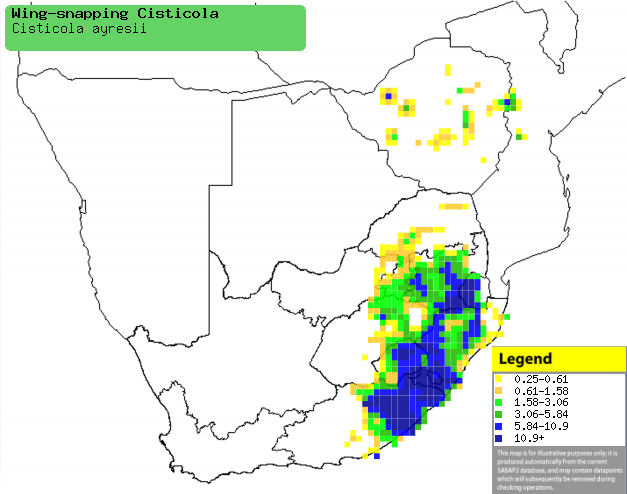|
Cisticola ayresii (Wing-snapping
cisticola, Ayres' cisticola)
Kleinste klopkloppie [Afrikaans]; Igqaza (also applied to
Cloud cisticola), Unogqaza, Uqandiliso [Xhosa]; iBhoyibhoyi (also applied to
Cloud cisticola) [Zulu]; Motintinyane (generic term for cisticolas and prinias)
[South Sotho]; Dwerggraszanger [Dutch]; Cisticole gratte-nuage [French];
Zwergpinkpink [German]; Fuinha de Ayres [Portuguese]
Life
> Eukaryotes >
Opisthokonta
> Metazoa (animals) >
Bilateria >
Deuterostomia > Chordata >
Craniata > Vertebrata (vertebrates) > Gnathostomata (jawed
vertebrates) > Teleostomi (teleost fish) > Osteichthyes (bony fish) > Class:
Sarcopterygii (lobe-finned
fish) > Stegocephalia (terrestrial
vertebrates) > Tetrapoda
(four-legged vertebrates) > Reptiliomorpha > Amniota >
Reptilia (reptiles) >
Romeriida > Diapsida > Archosauromorpha > Archosauria >
Dinosauria
(dinosaurs) > Saurischia > Theropoda (bipedal predatory dinosaurs) >
Coelurosauria > Maniraptora > Aves
(birds) >
Order: Passeriformes > Family: Cisticolidae
> Genus: Cisticola
 |
|
|
Wing-snapping cisticola, Cedara Farm,
Pietermaritzburg, South Afirica. [photo
Alan Manson
©] |
|
For information about this species, see
www.birdforum.net/opus/Wing-snapping_Cisticola
Distribution and habitat
It has scattered population across Africa south of the
Sahel, centered on the DRC but also occurring in southern Africa. Here it is
locally common in Zimbabwe, central Mozambique and South Africa, preferring
short grassland with patches of bare ground (e.g. on airfields).
|
 |
|
Distribution of Wing-snapping cisticola in
southern Africa, based on statistical smoothing of the records from
first SA Bird Atlas Project (©
Animal Demography unit, University of Cape Town; smoothing by
Birgit Erni and Francesca Little). Colours range from dark blue (most
common) through to yellow (least common).
See here for the latest distribution
from the SABAP2. |
Food
It mainly eats inveretebrates, plucking them from grass
stems and bare soil. The following food items have been recorded
in its diet:
Breeding
- The nest is a small ball-shape with an entrance on the side, built of dry
grass loosely secured with spider web. It is typically placed in a tuft of
grass facing a patch of bare soil, with some of the living grass stems bent
over the nest to form the roof.
- Egg-laying season is from September-March.
- It lays 2-5 eggs, which are incubated solely by the female for 11-14
days.
- The chicks stay in the nest for about 14-15 days.
Threats
Not threatened, although destruction of grassland on South
Africa's central plateau to make way for croplands is cause for concern.
References
-
Hockey PAR, Dean WRJ and Ryan PG 2005. Roberts
- Birds of southern Africa, VIIth ed. The Trustees of the John Voelcker
Bird Book Fund, Cape Town.
|
